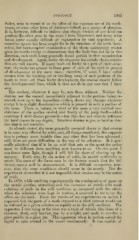Page 993 - My FlipBook
P. 993
ETIOLOGY. 1003 ;
Salter, seem to regard it as the effect of the vigorous use of the tooth-
brush, or some other form of friction—indeed, as a species of abrasion.
It is, however, difficult to believe that simple friction of any kind can
produce the eliect seen in the cases I have illustrated, and many other
tbrms occur equally difficult of explanation by that hypothesis. A
causative agency has been sought for in the structure of the teeth them-
selves, but microscopical examination of the tissue undergoing erosion
gives no results except to demonstrate that the fault does not lie in this
direction, such teeth being generally found perfect in their organization
and development. Again, faulty development has certain characteristics
that are well known. If many teeth are faulty in a part of their struc-
ture, the faults are present in those parts of each of the teeth in process
of development at the same time ; therefore, if what I have called
erosion were the washing out or brushing away of such portions of the
tooth as were soft from faulty development, the erosion should follow
the developmental lines, which it does not do in any case that I have
seen.
The erodent, whatever it may be, acts from without. Neither the
dentine nor the enamel immediately adjacent to the portions being re-
moved, even up to the immediate surface, shows any changes whatever
except it be a slight discoloration which is present in only a ^lortion of
the cases. There is, indeed, in most of the cases a very marked sen-
sitiveness of the surface eroded, and finally of the pulp itself—which
condition I shall discuss presently—but this does not seem to influence
the hard tissues in any degree. Sensitive dentine is just as hard as den-
tine that is not sensitive.
As already stated, the more generally accepted theory is that erosion
is in some way effected by acids, and, all things considered, this supposi-
tion is perhaps more tenable than any other that has been advanced
still, there are great difficulties in the way of its adoption. It is gen-
erally admitted that if it be an acid that acts as the agent the action
must be different from anything now known to us. On this point I
can throw some light, though I will fall far short of clearing up the
mystery. Teeth may, by the action of acids, be eroded artificially so
nearly like some of the forms seen in the human mouth that the dif-
ference cannot well be demonstrated. It is difficult to conceive, how-
ever, that the same conditions should occur in the mouth. But the
experiment shows that it is not impossible that erosion may be the action
of acids.
In 1870, while studying experimentally the condensation of gases on
the metals (surface attraction) and the corrosion of mi?tals with weak
solutions of acids in the still condition as compared with the effects
when the solutions were ke])t in motion, it occurred to me to try the
effects on the teeth. From the results of my experiments on metals I
supposed that the parts of a tooth exposed to a brisk current would not
be softened in a given solution so rapidly as in the still condition. The
apparatus I was using at the time was a train of wheels like those of a
common clock, only heavier, run by a weight and made to revolve a
glass paddle in a glass jar. This aj^paratus when in motion caused the
liquid to spin around in the vessel continuously. It was capable of


